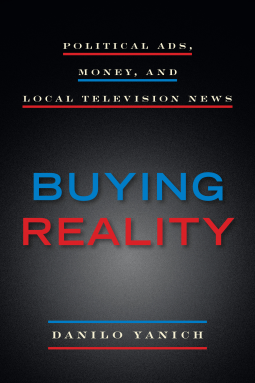
Buying Reality
Political Ads, Money, and Local Television News
by Danilo Yanich
This title was previously available on NetGalley and is now archived.
Send NetGalley books directly to your Kindle or Kindle app
1
To read on a Kindle or Kindle app, please add kindle@netgalley.com as an approved email address to receive files in your Amazon account. Click here for step-by-step instructions.
2
Also find your Kindle email address within your Amazon account, and enter it here.
Pub Date Apr 07 2020 | Archive Date May 30 2020
Talking about this book? Use #BuyingReality #NetGalley. More hashtag tips!
Description
From a certain perspective, the biggest political story of 2016 was how the candidate who bought three-quarters of the political ads lost to the one whose every provocative Tweet set the agenda for the day’s news coverage. With the arrival of bot farms, microtargeted Facebook ads, and Cambridge Analytica, isn’t the age of political ads on local TV coming to a close?
You might think. But you’d be wrong to the tune of $4.4 billion just in 2016. In U.S. elections, there’s a lot more at stake than the presidency. TV spending has gone up dramatically since 2006, for both presidential and down-ballot races for congressional seats, governorships, and state legislatures—and the 2020 campaign shows no signs of bucking this trend. When candidates don’t enjoy the name recognition and celebrity of the presidential contenders, it’s very much business as usual. They rely on the local TV newscasts, watched by 30 million people every day—not Tweets—to convey their messages to an audience more fragmented than ever.
At the same time, the nationalization of news and consolidation of local stations under juggernauts like Nexstar Media and Sinclair Broadcasting mean a decreasing share of time devoted to down-ballot politics—almost 90 percent of 2016’s local political stories focused on the presidential race. Without coverage of local issues and races, ad buys are the only chance most candidates have to get their messages in front of a broadcast audience.
On local TV news, political ads create the reality of local races—a reality that is not meant to inform voters but to persuade them. Voters are left to their own devices to fill in the space between what the ads say—the bought reality—and what political stories used to cover.
Advance Praise
"Yanich has written the most comprehensive study yet of political advertising and political issue coverage in local television markets. By carefully comparing national v. local coverage in ten cities he has found that while television stations profit greatly from political advertising, they make nearly no contribution to covering the critical downballot issues that affect their audiences as citizens. This is an important contribution to the scholarship on local television and its failure to adequately serve the public, for scholars and policymakers alike."--Lewis A. Friedland, Vilas Distinguished Achievement Professor in the School of Journalism and Mass Communication, UW-Madison
Available Editions
| EDITION | Other Format |
| ISBN | 9780823288960 |
| PRICE | $39.00 (USD) |
| PAGES | 256 |



